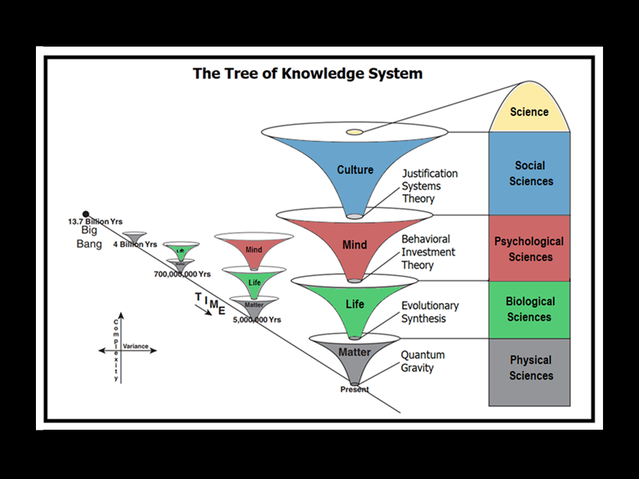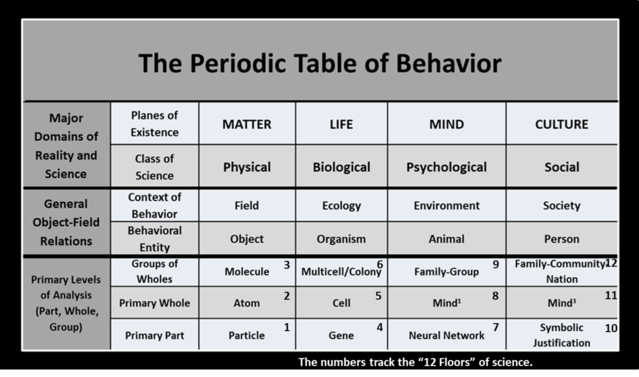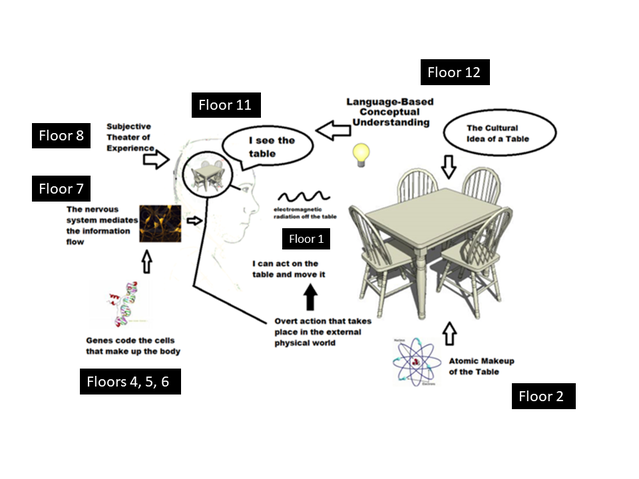Genetics
Seeing the World Through the Periodic Table of Behavior
The Periodic Table of Behavior gives us a scientific lens to see the world.
Posted April 2, 2021 Reviewed by Devon Frye
Key points
- Scientists see the world through the lens of different behaviors.
- The Periodic Table of Behavior (PTB) divides the natural world into three levels of analysis and four dimensions of complexity, giving us twelve floors of behavior.
- The PTB gives us a way to understand how scientific knowledge corresponds to the 12 floors of behavior.
- This means the PTB gives us a new scientific ontology; that is, it gives us a new way to see how science maps reality writ large.
What is the best way to look at the world? One way is via the lens of an artist, who sees opportunities for beauty and creative expression. Another way is that of the theologian, who appreciates and is humbled by its mystery and searches for ultimate meaning. Yet another way is as a scientist.
This blog invites you to see the world via the lens of a scientist. A scientist observes behavior in the world. That is, she looks at the world via a frame of reference, identifies objects and fields, and then tries to describe and explain changes in those object-field relationships. Consider, for example, the iconic story of Newton watching an apple fall and having the idea that objects with mass are attracted to each other and then working out the force of gravity.
The stance of a scientist is thus one who observes, describes, and tries to explain behavioral change. But this gives rise to a question: Given that there are so many different kinds of behavior, is there any way to see them from one frame of reference?
Most would say no. For most scientists, science is an epistemology. That is, it is a way of knowing or gathering knowledge about the world. The question suggests that there might be a single scientific vantage point to view reality. But there is no "general" natural scientific ontology. That is, there is no map of reality that aligns all our domains of scientific knowledge of it.
The Tree of Knowledge System is a proposal for a general scientific ontology. That is, it gives folks a map of the natural world, and it shows how all of our basic natural scientific knowledge might be mapped in relationship to it.

The ToK System starts with the argument that nature can be divided into four different dimensions of behavioral complexity. These dimensions are also called planes of existence. They are:
- Matter/Object
- Life/Organism
- Mind/Animal
- Culture/Person
The ToK posits that, following Matter, each plane emerges as a function of novel information processing systems and communication networks (i.e., genetic-living, neuronal-mental, linguistic-self-conscious justification). These are then corresponded to the physical, biological, psychological, and social sciences. Part of why the ToK is new is that it affords us a new way to think about scientific psychology.
The Periodic Table of Behavior grows out of the ToK System. It adds the point that each plane of existence can be divided into three levels of analysis. This is because each plane has a primary unit of behavioral organization. For the Matter dimension, the primary unit is the atom. For Life it is the cell, for Mind, it is the animal, and for Culture it is the person. The Periodic Table of Behavior says that from this primary unit, we can then go “lower” into parts that make up the unit or higher into “groups” units (which then go into larger and larger scales).
For the Matter dimension, there are parts of atoms called "particles," which are studied by particle physicists, and mapped by what is called "the standard model of elementary particle physics." Atoms are, of course, mapped by the Periodic Table of the Elements. And there are groups of atoms called molecules, the behaviors of which are studied by chemists.
As Matter grows in scale, it is studied by other sciences like earth science or astronomy. Likewise, there are parts of cells, such as genes studied by the sciences of genetics and molecular biology. And there are multi-celled organisms like trees, studied by scientists like botanists or, across scale, ecologists.
At the Mind dimension, we have parts of animal minds as neuronal networks and specific brain systems. And, of course, there are groups of animals, like troops of baboons, studied by primatologists and sociobiologists. For persons, there's the fundamental unit of linguistic thought, which the ToK frames as symbolic justification (i.e., a proposition). Of course, for groups of people, there are families, communities, nations, and at the largest scale transnational civilizations (i.e., the West or East or the global civilization).
This division of 3 levels of analysis (part, whole, group across scale) by the 4 dimensions of behavioral complexity gives the Periodic Table of Behavior (PTB). Here it is:

The PTB allows you to observe the world as a scientist. But not just as a scientist who is framed by scientific epistemology, but also someone who can see the whole of nature mapped by scientific ontology.
The 3 levels by 4 dimensions give rise to 12 floors (see here for more detail). Quantum mechanics is the first floor and its "base." When particle physicists are exploring the strange world of relativistic quantum field theory, they are exploring the strange way packets of energy information make up the particles and forces mapped by the standard model (see here for a great lecture on this "floor"). Similarly, if you hear a chemist talking about the role of carbon atoms in molecules, then you know that they are looking at the space between the second and third floors on the PTB.
If you are reading a research article that shows that crows appear to have subjective conscious experiences, then you know that these researchers at looking at the 8th floor on the PTB. Likewise, if you read an article by archeologists and anthropologists to understand the harsh life of children who lived in Viking societies, you are reading about the 12th floor of behavior (human groups and societies). As a clinical psychologist who engages in psychotherapy, I generally work professionally with individuals struggling with mental health issues. I see individual people via the lens of the 11th floor on the PTB.
If we take an everyday example of a person looking at a table, we can map the natural world this way:

Note, the table itself does not fit into the taxonomy because it was made by people and thus is technology, or "material" culture.
Science is about observing, describing, and explaining the world through behavioral glasses. This is scientific epistemology, meaning it is how scientists know things. However, the real fruit of science is the knowledge it produces. This is scientific ontology. The Periodic Table of Behavior divides the world of behavior into three levels and four dimensions. When placed in the context of the ToK System and larger Unified Theory of Knowledge, it gives us a new way to see the layers of the natural world, grounded in a coherent scientific ontology.




